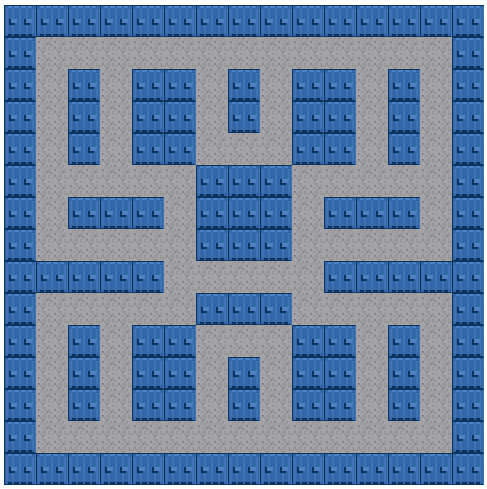A* Applied to a Larger Tile Map
To demonstrate A* path finding in a more real-world way, we must first create a new tile map. For our next example, we are going to create a more maze-like structure that still uses just the first two tile types.
The following code example shows the changes to the Example 8-13 tile map for Example 8-14. We will also be changing the
startNode and endNode for Example 8-14. We have not provided the full
code listing for this example, just the changes needed to turn Example 8-13 into Example 8-14:
//Example 8-14 changes to Example 8-13 to make a larger tile mapvarmapRows=15;varmapCols=15;vartileMap=[[0,0,0,0,0,0,0,0,0,0,0,0,0,0,0],[0,1,1,1,1,1,1,1,1,1,1,1,1,1,0],[0,1,0,1,0,0,1,0,1,0,0,1,0,1,0],[0,1,0,1,0,0,1,0,1,0,0,1,0,1,0],[0,1,0,1,0,0,1,1,1,0,0,1,0,1,0],[0,1,1,1,1,1,0,0,0,1,1,1,1,1,0],[0,1,0,0,0,1,0,0,0,1,0,0,0,1,0],[0,1,1,1,1,1,0,0,0,1,1,1,1,1,0],[0,0,0,0,0,1,1,1,1,1,0,0,0,0,0],[0,1,1,1,1,1,0,0,0,1,1,1,1,1,0],[0,1,0,1,0,0,1,1,1,0,0,1,0,1,0],[0,1,0,1,0,0,1,0,1,0,0,1,0,1,0],[0,1,0,1,0,0,1,0,1,0,0,1,0,1,0],[0,1,1,1,1,1,1,1,1,1,1,1,1,1,0],[0,0,0,0,0,0,0,0,0,0,0,0,0,0,0]];
If we create a tile map like the above, it will result in a map that looks like Figure 8-13, which shows the output from the new, larger tile map that will be generated from this data.

Figure 8-13. The Example 8-14 15×15 tile map with no path finding applied
Along with ...
Get HTML5 Canvas, 2nd Edition now with the O’Reilly learning platform.
O’Reilly members experience books, live events, courses curated by job role, and more from O’Reilly and nearly 200 top publishers.

